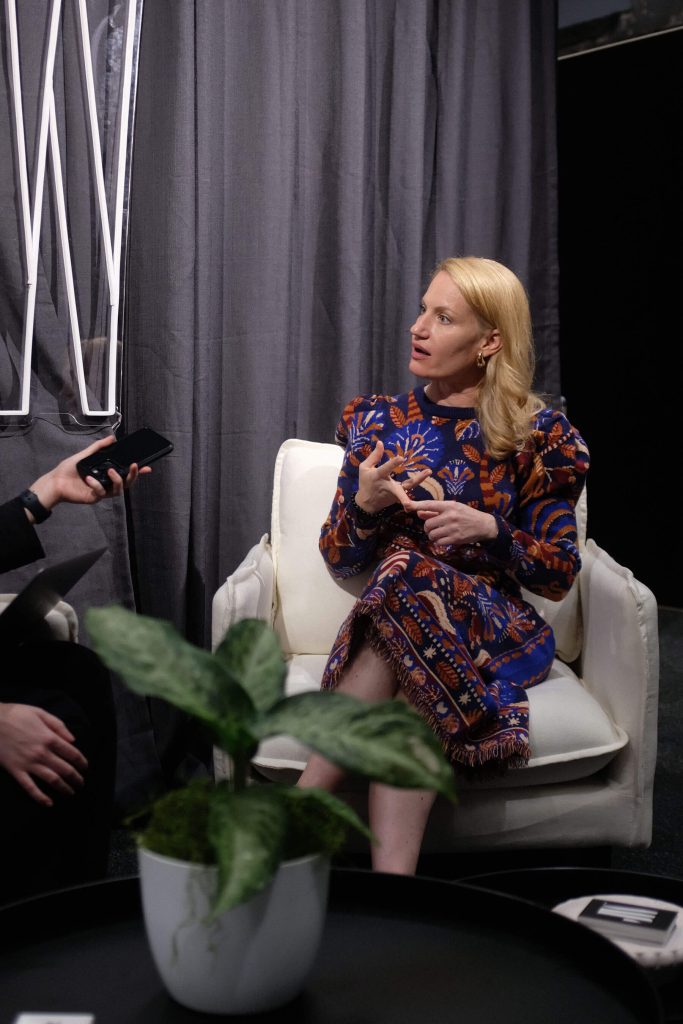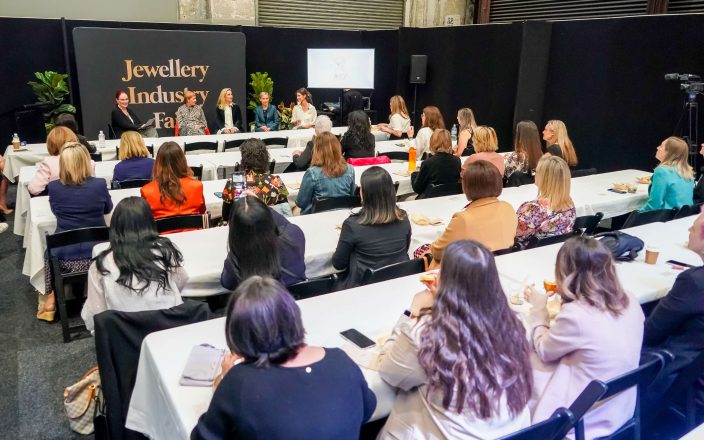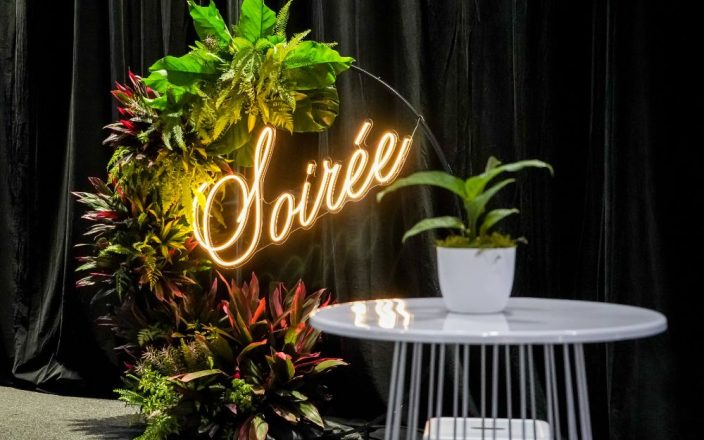Recently, at the Jewellery Industry Fair, Ashie Luke spoke to Andrea Lucille Pooler, the business management lead of Hill & Co. in New York.
AL: Can you give me an example of how your workshop helps a jewellery business improve its performance? How does this relate to your expertise in the industry?
AP: [For] my expertise in the industry, I have a vast background [in] running my own business [rather] than working in the corporate jewellery industry in a factory. In that position, I manage multiple teams. My background [in] the management aspect and different backgrounds of the people that I managed, and the different departments all run differently, translate really easily into a talk and a discussion about leadership specifically [for] people in the jewellery industry.
AL: With the unique challenges in the jewellery industry, what leadership approaches have you found most effective, and how do they align with encouraging success in this industry?
AP: I think just being open with your employees and creating a culture where anybody can come and approach you, have a conversation, and just being an empathetic leader—I think all of those are great things to have [when] creating educational options or classes or the ability to maybe go back to school. [They] are great things to offer employees. I would say the last [point] is creating a company culture [by] going out and doing things together outside of the work area. Get to know the person on a different level [by] asking them things that you wouldn’t necessarily know about them.
AP: When I led my teams at James Allen, I got to know them on a personal level and I would do things for each of them. For example, the last Christmas that I was actually there, I asked them each for a photo of a family member, and I took that photo, did a drawing, and framed it for each of my core employees. I couldn’t do this for everybody, but I did it for my main team. In order to do this, I actually started this project in September. What it does is show how much I really did appreciate them. Believe me, there [were] more than a couple of tears when I handed this gift to them during Christmas… I felt like my teams were my family in a lot of ways. [If] any of them called me today and needed my help for anything, I would be right there for them.
AL: Absolutely. That’s very nice. I wish I had a little Christmas gift now!
AP: [laughter]
AL: Communication intricacies can impact jewellery businesses significantly. How do your insights, tailored for the jewellery sector, address communication challenges and enhance team collaboration?
AP: Communication is key to everything. You need to make sure that you provide communication in multiple ways because not everybody hears it, listens to it, or reads it the same way. It needs to be verbal, it needs to be written, it needs to be emailed, and then you need to repeat it multiple times. One fun fact I have is that in any conversation you might have with somebody, they are only going to remember 50 percent of what you’ve told them. Continually repeating [yourself] over and over and over again is what you have to do, and then provide the information in different ways. Providing communication in multiple ways is the best way to make sure that your teams align with [what] you’re doing and the information you’re putting out there.
AL: Absolutely. I completely agree. You mentioned on LinkedIn that this talk and workshop are the most personal ones you’ve done. Could you elaborate on why this particular event holds a special place and how your personal experiences have shaped the content you’ve shared?
AP: All three talks have a little bit of me in [them]… for example, the first talk today was about branding and marketing. That lent itself to running my own business for the 15 years that I did. Even starting out when I was 12 years old, I made jewellery and started branding then. The leadership aspect [of] that talk has more of a background in the corporate jewellery industry, working in a factory, and managing multiple teams. And then, of course, the [women’s] bench jeweller talk goes back to when I had my own business, in different aspects of that, my struggles and my wins.
AL: Yeah, absolutely. [These] are both important. In an industry dominated by luxury brands and marketing powerhouses, standing out can be a challenge. Could you share an instance from your career where you successfully differentiated yourself and your work? And how does this insight influence your message?
AP: I would have to say the first thing is the product. What product [are you] selling? Is there a story behind it? How is it unique? What is your USP? What makes it unusual? What’s going to make somebody want to purchase your jewellery? It’s the first thing [when] I look at any jewellery brand. And if there’s nothing unique or no story behind it, that’s when I just walk right on.

AP: [What] I did when I had my own company because I didn’t have a big marketing budget was I applied to a lot of competitions. I sent my jewellery to different magazines and did a lot of jewellery exhibitions, where events would give me more publicity. Some of these events would have an award ceremony where they would pick the three top designs they liked at the show. If you could win any of those designs, which I did win many, that brings more people to your booth and your location during the show. Focusing on the marketing things that you could do that are free. It’s very easy to fill out an application for a competition. You just need to make sure you have the right product for the right competition.
AL: Yes, definitely. After participating in your workshops and hearing your talks, how do you expect attendees to experience a transformation in their leadership approach, communication strategies, or employee skill enhancement?
AP: If you listen to any of my talks, you’ll hear me repeat a similar theme, whatever that might be, throughout the talk. You need to repeat yourself over and over to get one point across. I hope they leave with at least three things they can take back to their store or studio and implement.
AL: In an ever-changing industry, how do your workshops stay relevant and adaptable? How does your industry expertise contribute to providing effective strategies for business in this way?
AP: That comes back to what I’m doing right now at Hill & Co. I’m the business management lead and principal consultant. I’m working with multiple companies from mine to market, including retailers. And so I have my boots on the ground. I’m seeing everything that’s going on behind the scenes. That’s what keeps me relevant. Also, solving their problems. What are their current problems, and [what are] the solutions? A lot of that [happens] with technology. It’s a lot of technology. I’m constantly looking to see what new technology is out there in the jewellery industry or that applies to the jewellery industry. How will that help my client? I’m constantly doing demos, and then you want to [analyse] that demo and [compare] everything you’ve seen. You can make the right recommendation for the right client.
AL: So you’re just all over, problem solver, it seems like!
AP: Yes, yes, yes!
AL: As this is your first visit to Australia and your first time at the Jewellery Industry Fair, how do you anticipate your extensive background? How do you think this will resonate with the Australian audience?
AP: Since I’ve been here and I’ve only been here a week, what I see is very similar to the American market. It’s just a micro version of it. I see that it is very parallel to the US market, I feel like everything that I’m saying should translate.
AL: Yeah, absolutely. I think it is so far, after the turnout to your talk just before! As the jewellery industry keeps evolving, how do you make sure you provide insights that align with the current trends and guide people for long-term success?
AP: One of the things I like to say to my customers is, “You need to have a plan.” What is your plan? Do you have a Gantt chart? A lot of people can’t see past the end of their nose, and that’s not because they don’t want to. It’s because they’re running businesses and have too many things flying at them all over the place. So what I do is I really come in. and give them a different perspective, a different point of view than maybe they’ve never thought of, and it doesn’t mean that they wouldn’t have come up with it on their own. The problem is they just don’t have enough time to even sit down and think about it. I’m there to really show a different perspective and challenge them. I’m not always going to agree with my clients. There are many times when I say, “No, I don’t agree with you, and this is why I don’t agree with you.” When I go into a project, I think of my client as I think of it as my own business. Because I ran my own business for 15 years, I don’t know how to be any other way. Every client I have, every job I’ve ever had, I always felt like it was my own business… I’m very passionate about it—it makes life easier. It’s an easy job because I enjoy doing what I’m doing.


